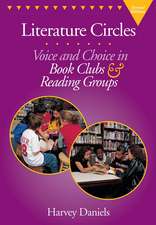Internet Links for Science Education: Student - Scientist Partnerships: Innovations in Science Education and Technology, cartea 4
Editat de Karen C. Cohenen Limba Engleză Paperback – 30 iun 1997
Din seria Innovations in Science Education and Technology
- 24%
 Preț: 732.43 lei
Preț: 732.43 lei -
 Preț: 394.87 lei
Preț: 394.87 lei - 15%
 Preț: 636.80 lei
Preț: 636.80 lei -
 Preț: 390.63 lei
Preț: 390.63 lei -
 Preț: 386.22 lei
Preț: 386.22 lei -
 Preț: 381.98 lei
Preț: 381.98 lei -
 Preț: 383.93 lei
Preț: 383.93 lei -
 Preț: 391.02 lei
Preț: 391.02 lei -
 Preț: 397.16 lei
Preț: 397.16 lei - 15%
 Preț: 640.24 lei
Preț: 640.24 lei - 15%
 Preț: 639.41 lei
Preț: 639.41 lei - 18%
 Preț: 947.85 lei
Preț: 947.85 lei - 18%
 Preț: 962.66 lei
Preț: 962.66 lei -
 Preț: 379.86 lei
Preț: 379.86 lei - 15%
 Preț: 647.59 lei
Preț: 647.59 lei - 15%
 Preț: 649.39 lei
Preț: 649.39 lei -
 Preț: 393.35 lei
Preț: 393.35 lei - 15%
 Preț: 641.53 lei
Preț: 641.53 lei - 18%
 Preț: 900.94 lei
Preț: 900.94 lei - 18%
 Preț: 1000.70 lei
Preț: 1000.70 lei -
 Preț: 386.81 lei
Preț: 386.81 lei -
 Preț: 383.93 lei
Preț: 383.93 lei - 15%
 Preț: 585.73 lei
Preț: 585.73 lei -
 Preț: 394.87 lei
Preț: 394.87 lei - 18%
 Preț: 891.93 lei
Preț: 891.93 lei -
 Preț: 392.97 lei
Preț: 392.97 lei
Preț: 388.13 lei
Nou
Puncte Express: 582
Preț estimativ în valută:
74.28€ • 77.26$ • 61.32£
74.28€ • 77.26$ • 61.32£
Carte tipărită la comandă
Livrare economică 14-28 aprilie
Preluare comenzi: 021 569.72.76
Specificații
ISBN-13: 9780306455582
ISBN-10: 0306455587
Pagini: 260
Ilustrații: XX, 260 p. 36 illus., 1 illus. in color.
Dimensiuni: 155 x 235 x 19 mm
Greutate: 0.42 kg
Ediția:1997
Editura: Springer Us
Colecția Springer
Seria Innovations in Science Education and Technology
Locul publicării:New York, NY, United States
ISBN-10: 0306455587
Pagini: 260
Ilustrații: XX, 260 p. 36 illus., 1 illus. in color.
Dimensiuni: 155 x 235 x 19 mm
Greutate: 0.42 kg
Ediția:1997
Editura: Springer Us
Colecția Springer
Seria Innovations in Science Education and Technology
Locul publicării:New York, NY, United States
Public țintă
ResearchCuprins
New Pathways in Science Education—The Internet, Technology, and SSPs.- 1. Student–Scientist Partnerships: Shrewd Maneuvers.- A New Partnership.- The Educational Importance of SSPs.- The Research Importance of SSPs.- Technology as Facilitator.- Next Steps.- References.- 2. The GLOBE Program: A Model for International Environmental Education.- The GLOBE Program and Earth Systems Science.- The GLOBE Program and Education.- GLOBE Student Visualizations.- GLOBE Computer and Communications Systems.- Implementing the GLOBE Strategy.- GLOBE in Action.- GLOBE Management.- Joining GLOBE.- References.- 3. FeederWatch: An Example of a Student-Scientist Partnership.- The FeederWatch Process.- Scientific Results.- Accuracy of Data.- Educational Results.- CFW Overview.- CFW Progress to Date.- The Future of CFW.- The Future of Project FeederWatch.- The Relationship between Science and Education.- Conclusion.- Acknowledgments.- References.- 4. The Science that Happens through Partnerships: Sun Photometer Atmospheric Network (SPAN).- Doing Science.- Some Strategies for Implementing SSPs.- An SSP Wish List.- References.- 5. The Aquanaut Program.- Advanced Technologies.- Linking Education and Research.- AP Research.- Impacts of the AP.- Summary.- References.- 6. EARTHWATCH: Science Education Worldwide.- EARTHWATCH Exposes Teachers to Technology.- EARTHWATCH Projects: Case Studies.- EARTHWATCH Expands Learning to Infinite Realms.- Sources.- 7. Mars Exploration: Students and Scientists Working Together.- Goals for the Scientists.- Goals for the Students.- Three Examples of the Student-Scientist Collaboration.- Making the Partnership Work.- The Roles of Technology.- A Grand Experiment.- Contacts.- 8. Validating Student Data for Scientific Use: An Example from the GLOBE Program.-Background.- Protocols and Activities.- Additional Ongoing Research.- Example Exercise.- Student Activity: Bird Classification.- References.- 9. Student Data Acquisition: An Important Component of Student–Scientist Partnerships.- Using Computerized Data Acquisition Systems.- Examples of Data Acquisition Projects in Education.- Industry’s Tools of Today Mean Educational Use Tomorrow.- Validation of Student–Collected Data.- References.- 10. Role of Technology in Student–Scientist Partnerships: Perspective from the National Science Foundation.- Inquiry and Design; the Infosphere and Complexity.- A Look at SSPs and Technology.- The Role of Research and NSF Support.- Summary.- Acknowledgments.- References.- 11. Science Education as Driver of Cyberspace Technology Development.- The CoVis Project.- Notes.- References.- 12. Image Processing: An Enabling Technology for Science Research, Teaching, and Learning.- What Is Image Processing?.- Premise of the IPT Project.- The IPT Experiment.- Impact of IPT in Schools.- Dissemination.- IPT and the Internet.- Conclusion.- References.- Appendix Student-Scientist Partnerships.
Recenzii
`The broad spectrum of contributors and the innovative perspectives revealed in the case studies make this book an invaluable resource for teachers and an exemplary tool for students.'
John F. `Kip' Perkins III, Ten Acre Country Day School, Wellesley, MA.
John F. `Kip' Perkins III, Ten Acre Country Day School, Wellesley, MA.






